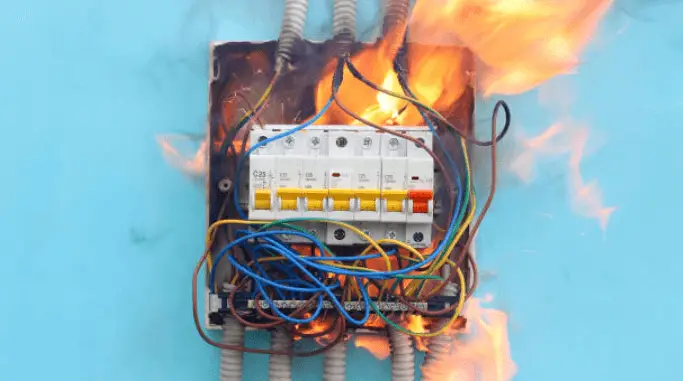Landlords and tenants each have unique roles to play in property maintenance, and for both parties, ensuring electrical safety and functionality should be a priority. Renters, especially those who spend most of their time in the unit, should be vigilant and on the lookout for electrical faults. Knowing how to detect faulty wiring in a rental is crucial for safety and convenience.
But faulty wiring goes beyond troubleshooting TV problems. From flickering lights to charred outlets, understanding the warning signs and knowing when to seek professional help is essential. Are you a tenant looking to stay informed and proactive, or a landlord searching for a comprehensive guide to share with your renters? Stick around; this article explores how anyone can identify potential electrical issues in their rental homes. Let’s get started:

How to Detect Faulty Wiring in a Rental?
Broken Covers
Loose or broken covers can indicate faulty wiring or unsafe electrical conditions in a rental property. Broken covers can expose wiring, increasing the risk of electrical shock or fire. As such, they’re a significant code violation, and tenants should report them promptly.
Electrical Switches Being Out of Order
Switches acting up can be a sign of an underlying electrical issue. Often, it indicates an internal wiring problem and a short or overloaded circuit. Instead of running the risk of fixing a faulty switch, it would be best to contact a qualified electrician. Residential property managers in Northern Virginia can guide you on how to report emergency maintenance.
Frequent Tripping of Circuit Breaker
Circuit breakers trip when circuits are overloaded or short-circuited. So, if your circuit breaker frequently trips, it’s a sign of potential wiring issues. Left unchecked, a frequent tripping of the circuit breaker could be an electrical hazard.
Flickering Lights
Another sign something might be wrong with your electrical system is if you experience flickering lights. Lights that flicker or dim without an apparent cause can indicate wiring problems, especially considering these fixtures draw a minute amount of power. Often, blinking lights indicate that a major appliance on the same circuit is drawing a lot of energy.
Burning Odors
One of the benefits of home preventative maintenance is that it helps landlords and tenants detect damaged wiring, improper installation, and avoid circuit overload. When these are left unchecked, they can overload your outlets and produce a funny odor. Unusual burning or smoky smells near outlets or electrical panels should be investigated immediately. Once you’ve identified it, turn it off, unplug any connected appliance, and contact an electrician.
Outdated Wiring
Older properties may have outdated, unsafe wiring that requires an upgrade. Contact your landlord for a professional electrical inspection if you suspect faulty wiring. Regarding electrical issues, it would be best not to attempt DIY repairs because of the risks involved.
Sparks

Visible sparks or electrical arcing are clear signs of wiring issues. They’re a serious safety hazard because they could quickly start an electrical fire or shock someone. Sparks in your outlets often indicate loose connections, frayed wires, or overloaded circuits.
Hot Switch Plates
Switch plates that feel excessively hot when touched may indicate problems. Even when you connect an appliance that generates heat, the outlet should not be warm or hot to the touch. If you notice a switch plate rises in temperature after plugging something into it, suspend using that outlet and report the issue.
Landlord-Tenant Responsibility for Electrical Problems
The responsibility for electrical problems in a rental property isn’t a one-size-fits-all rule. Depending on the issue’s nature, the lease agreement’s terms, and local laws, it can vary. But here’s a general guideline:
Landlord’s Responsibility
- Wiring and Electrical Systems: Landlords are typically responsible for the property’s electrical wiring, circuitry, and the main electrical panel. That includes repairs to the central electrical system and ensuring it complies with safety codes.
Tenant’s Responsibility
- Tenant-Related Damage: If electrical problems result from tenant actions, such as overloading circuits or damaging outlets, tenants may be responsible for repair costs.
- Appliances: Electrical issues related to tenants’ appliances (e.g., a malfunctioning microwave) are usually the tenant’s responsibility. However, in furnished or semi-furnished apartments, maintenance of appliances provided by the landlord is their responsibility.
Conclusion
In conclusion, how to detect faulty wiring in a rental property is a shared responsibility between landlords and tenants. Tenants are crucial in identifying warning signs such as broken covers, out-of-order switches, and frequent circuit breaker tripping. And they should promptly report these issues to maintain safety within the rental property. Landlords should then address these issues promptly to ensure tenant safety.
Understanding the division of responsibilities for electrical problems is also essential to ensure each party does its part in keeping the rental safe. While landlords are typically responsible for the property’s electrical system, renters’ responsibilities often encompass tenant-induced issues or problems with personal appliances. A property manager could help both parties understand these responsibilities, as outlined in the lease agreement, and help address electrical issues promptly and ensure a safe living environment for everyone.
